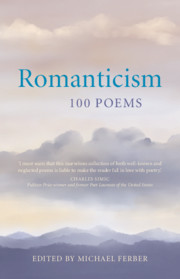Book contents
- Romanticism: 100 Poems
- Romanticism: 100 Poems
- Copyright page
- Contents
- Introduction
- Part
- Part
- Part
- Part
- Part
- Part
- John Clare (1793–1864; English)
- Felicia Dorothea Hemans (1793–1835; English)
- William Cullen Bryant (1794–1878; American)
- John Keats (1795–1821; English)
- Annette von Droste-Hülshoff (1797–1848; German)
- Alfred de Vigny (1797–1863; French)
- Heinrich Heine (1797–1856; German)
- Giacomo Leopardi (1798–1837; Italian)
- Part
- Part
- Part
- Part
Alfred de Vigny (1797–1863; French)
Published online by Cambridge University Press: 17 February 2021
- Romanticism: 100 Poems
- Romanticism: 100 Poems
- Copyright page
- Contents
- Introduction
- Part
- Part
- Part
- Part
- Part
- Part
- John Clare (1793–1864; English)
- Felicia Dorothea Hemans (1793–1835; English)
- William Cullen Bryant (1794–1878; American)
- John Keats (1795–1821; English)
- Annette von Droste-Hülshoff (1797–1848; German)
- Alfred de Vigny (1797–1863; French)
- Heinrich Heine (1797–1856; German)
- Giacomo Leopardi (1798–1837; Italian)
- Part
- Part
- Part
- Part
Summary
Vigny was born near Tours into a noble family that had suffered under the Terror. After moving to Paris he was sent to a school where his classmates regularly beat him for having “de” in his name; he was then tutored at home. When Napoleon was defeated, Vigny fulfilled his family’s expectations and joined the Royal Guard, where he served ten years as a lieutenant. He was interested in literature as a boy, but it was his friendship with Victor Hugo beginning in 1820 that ignited his creative energies. A volume of Poèmes soon appeared; an historical novel Cinq-Mars (inspired by Walter Scott, whom he met in Paris) in 1826; then translations of several plays of Shakespeare; and finally, several plays of his own, of which one, Chatterton (1834), was a success on stage.
- Type
- Chapter
- Information
- Romanticism: 100 Poems , pp. 113 - 116Publisher: Cambridge University PressPrint publication year: 2021

